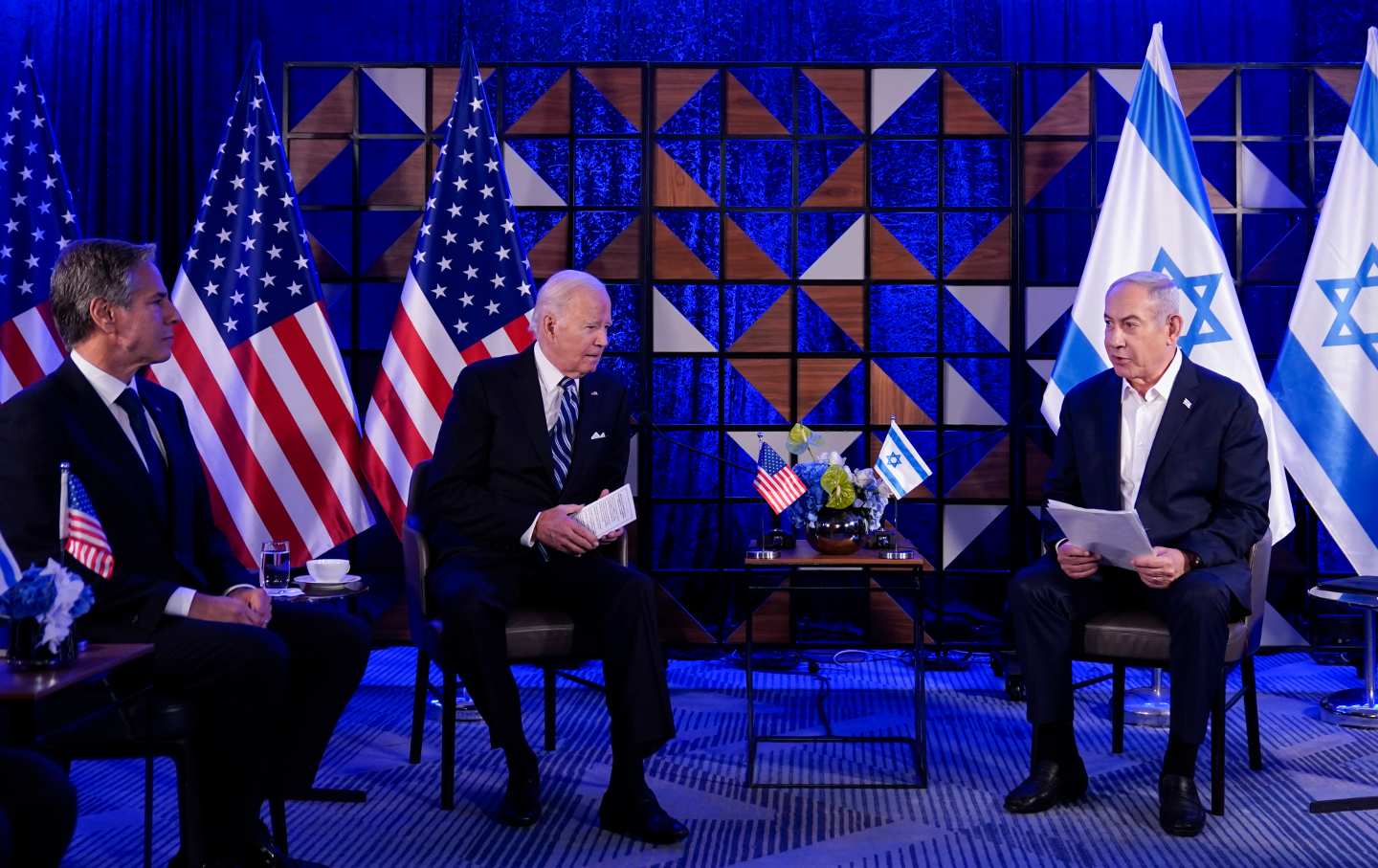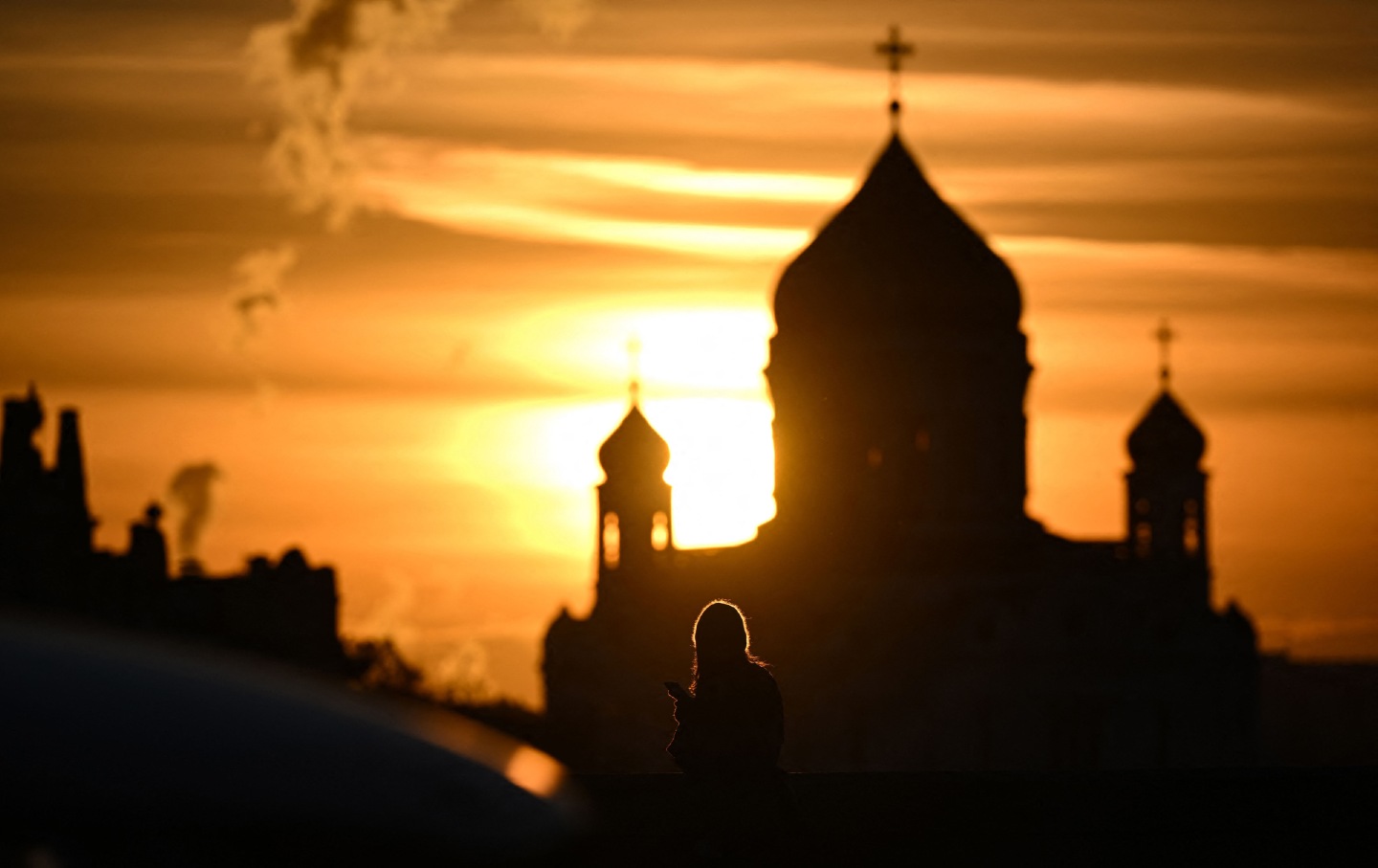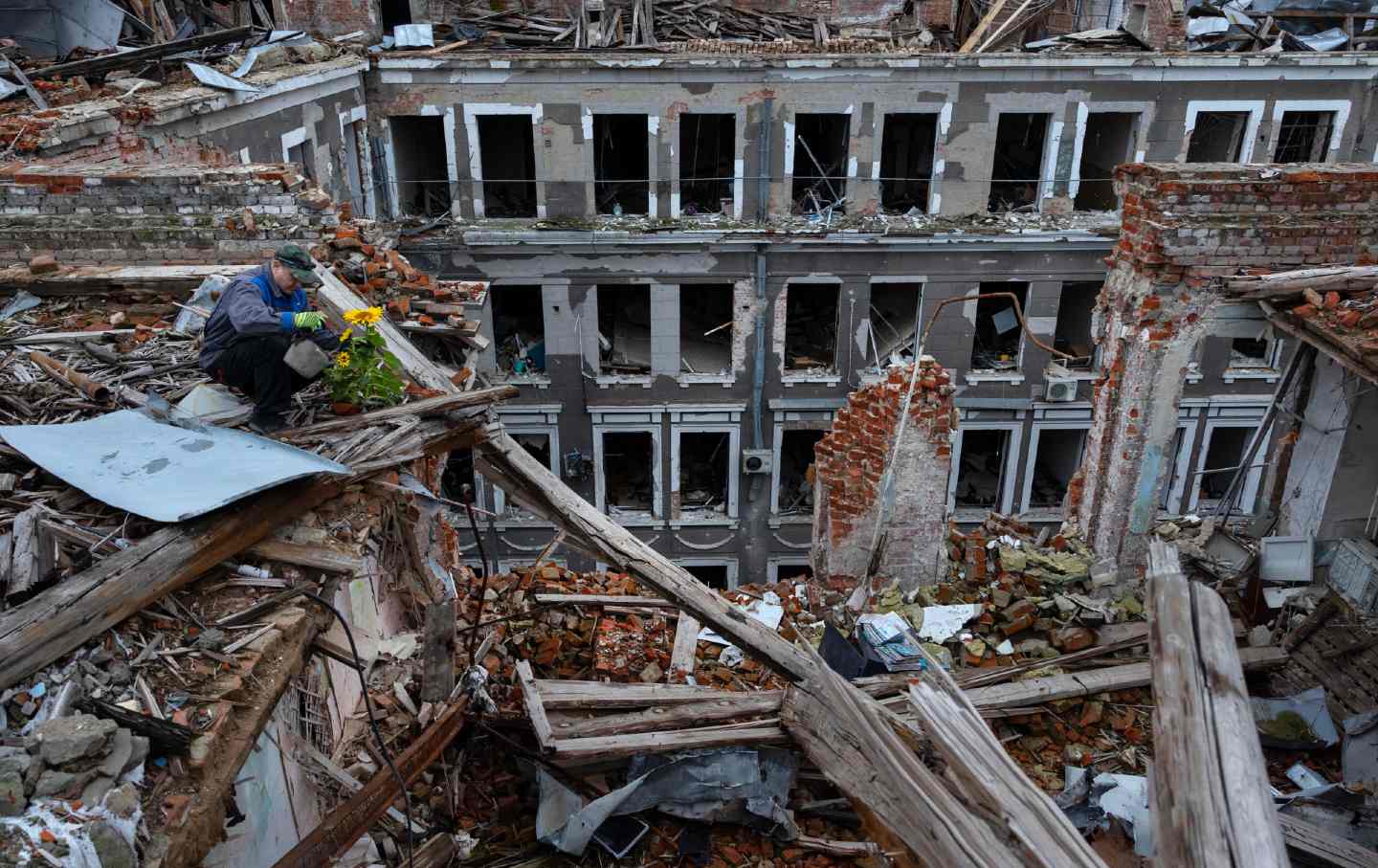The US and Israel Think They Can Decide Gaza’s Future. Here’s Why They’re Wrong.
Biden and Netanyahu are clinging to old imperial models about what to do with Gaza. But their plans are doomed to fail.

Benjamin Netanyahu meets with Joe Biden and Antony Blinken in Tel Aviv on October 18, 2023.
(Evan Vucci / AP)Israel’s relentless bombardment of Gaza shows no signs of stopping, but the United States is already thinking about what should happen when the bloodshed ends.
Speaking to reporters last week, US Secretary of State Antony Blinken suggested that the territory’s governance should be unified with the West Bank, and laid out a series of edits for the future of Palestine.
“Gaza cannot continue to be run by Hamas,” Blinken said. “It’s also clear that Israel cannot occupy Gaza…. it is imperative that the Palestinian people be central to the governance of Gaza and the West Bank.
Blinken’s parameters were defied days later by Israel’s Prime Minister Benjamin Netanyahu, who declared, “IDF forces will remain in control of the Strip,” and made clear that he will not allow the Palestinian Authority to play a role there. (Netanyahu then told Fox News that Israel “does not seek to occupy” Gaza, though, given the facts on the ground, it is hard to know how Israel defines “occupation.”)
The back-and-forth over what comes next in Gaza has prompted headlines like this one from NBC News: “The gap between the Biden administration and Netanyahu government over Gaza’s future is widening.”
But there is a glaringly absent party in these conversations: the Palestinian people themselves. Nobody seems particularly interested in what they might have to say about the future of their land.
Unfortunately, this is nothing new. Palestinians have long been accustomed to outsiders dictating what their land should look like and how it should be ruled. Britain’s 1917 Balfour Declaration promised a Jewish homeland in Palestine; the League of Nations mandate authorized British rule there; and the 1947 UN partition plan called for the country to be divided in two. In more recent years, Donald Trump’s “deal of the century” reimagined Palestine as an archipelago of townships and factories, connected via tunnels to ensure that the sight of Palestinians would not disturb Israelis living above.
Today, Netanyahu and Blinken’s designs for Gaza seem particularly egregious, with the former killing over 11,000 people there using weapons supplied by the government of the latter—a government that has steadfastly refused to call for a cease-fire, has labeled the few American politicians who have done so “repugnant,” and has never held Netanyahu or his extremist coalition to account—either for defying US policy or for blatantly violating international law, both before and after Hamas’s attack on October 7.
But aside from the audacity, these ideas are poorly thought-out and are likely to fail.
Cynics, for instance, might find some contradiction in Blinken’s assertion that Palestinians should have a role in their own governance, as long as they exclude arguably their most popular political party. Others might point out that refusing to accept Hamas’s rule in Gaza has been US policy since the George W. Bush era, but that hasn’t precluded Hamas from actually ruling Gaza. (Some—like the UN—might even be surprised to find out that Israel apparently has not been occupying Gaza this whole time.)
Israel’s 2005 “withdrawal” from Gaza was spurred by the high cost of maintaining its settlers and soldiers there under fire from Palestinian armed resistance. If the Israeli military does prolong its presence inside Gaza, that cost will likely be much higher and much bloodier than before, as the capabilities of Palestinian fighters have grown exponentially in the intervening years.
The cost would also be political.
When it removed its soldiers and settlers from the Gaza Strip, Israel tried to absolve itself, as the occupying power, of its responsibility for the well-being of Gaza’s population. It also hoped to subtract that population from the demographic ledger Israeli leaders worry so much about—convenient arithmetic when you fashion yourself as a Jewish and democratic state but the majority of people under your rule are not Jewish and have no political rights.
But if Israeli tanks do remain in Gaza, Israel will lose once more. Gaza will no longer be “exceptionalized,” its status different and separate from the occupied West Bank, where the Israeli military is ubiquitous. The two territories will once again be seen as a single political unit, especially if, as the United States hopes, the Israel-allied, West Bank–based Palestinian Authority (PA) can return to Gaza.
Popular
“swipe left below to view more authors”Swipe →Currently, the PA functions mostly as Israel’s security subcontractor. Its 60,000 guns are aimed exclusively at dissidents and those fighting Israel. Not a single bullet is fired in defense of Palestinians from daily Israeli military raids or settler violence. On the face of it, expanding that setup to Gaza seems ideal for Israel. But the political unification of Gaza and the West Bank is a big risk to an Israeli leadership wary of creating any momentum for Palestinian independence. It’s why Netanyahu has worked hard to undermine reconciliation efforts between Hamas and the PA, even if that meant the continuation of Hamas’s rule in Gaza. In 2019, he explained his reasoning to his party’s ministers thus: “Anyone who wants to thwart the establishment of a Palestinian state has to support bolstering Hamas and transferring money to Hamas. This is part of our strategy—to isolate the Palestinians in Gaza from the Palestinians in the West Bank.”
Even if that isolation is broken, it’s unlikely that the Palestinian Authority’s current leadership—corrupt, kleptocratic, and beholden to Israel’s intelligence agencies—would actually deliver for Palestinians. But PA President Mahmoud Abbas is 87 years old. There’s no guarantee that future PA leaders will be as pliant as he has been, which explains Netanyahu’s rejection of a PA presence in Gaza.
However, if the United States does convince Israel to support PA rule in Gaza, it would only highlight the lack of foresight that has characterized the Biden administration during this conflict.
The PA is extremely unpopular. As repressive as it has been internally, it has been impotent in the face of Israel’s colonial settlement project, and a bystander (at best) as the Israeli siege suffocated Gaza. If it offers nothing but an expansion of that kind of rule into Gaza, Palestinians there are unlikely to welcome its return—especially if it arrives on the back of an Israeli military that has just carried out such unconscionable slaughter. It would also likely be the target of an organized, motivated, and better-equipped opponent in Hamas.
And therein lies the rub. Because all this talk of who will rule postwar Gaza and all the sober-sounding statements about the need to eliminate Hamas conveniently ignores what is the most likely outcome: that Hamas, both as a military force and a political movement, survives.
Despite the massive destruction wrought by Israel’s air force and artillery and a civilian death toll that has produced revulsion and outrage around the world, there is little to suggest that Hamas’s military capabilities have been severely degraded. Its fighters are engaging Israeli armor in sporadic street battles amongst the apocalyptic ruins of northern Gaza. Its tunnel system, constructed for this type of war, does not seem to have been compromised. And its rocket silos are still unleashing daily volleys at Israeli towns and cities. Israeli officials have portrayed the ongoing battle around Gaza City as potentially decisive, but Hamas is just as strong in the southern half of the Gaza Strip that the Israeli military has not entered.
If the effort to destroy Hamas fails, it won’t be the first time US and Israeli efforts have come up short in this regard. Famously, the US desire to nullify the results of the 2006 Palestinian Authority legislative elections (which Hamas won) ended in the counter-coup that removed the PA from Gaza in the first place, solidifying Hamas’s control there.
Successive Israeli wars on Gaza since then (in 2008–09, 2012, 2014, and 2021) have neither toppled—or even meaningfully weakened—Hamas; in fact, the group emerged stronger each time. This isn’t because Gaza wasn’t bombed enough, but because there has been no desire to reckon with what Hamas actually is: a nationalist movement that seeks to liberate Palestinian land from Israeli occupation and realize the right of return for Palestinian refugees.
That’s clear in the lazy effort to conflate Hamas with groups like ISIS—a convenient analogy when you don’t want to engage with the political cause Hamas represents. Reducing a political movement to its most violent tactics also makes it easy for cable news pundits to opine on what must be done without having to think about the Nakba, the occupation, or apartheid. Policymakers who portray themselves as tough realists don’t have to acknowledge Hamas’s efforts over the years to enter into long-term truces with Israel, its tacit acceptance of the two-state solution (which US and European politicians robotically affirm as the only possible resolution), its attempts to reconcile with the Palestinian Authority or its backing of nonviolent tactics.
Many, if not most, Palestinians don’t necessarily share Hamas’s Islamist ideology or back its often underwhelming political leadership. But the group maintains a large amount of support because it is seen as the only party committed to fighting Israel’s settler-colonial domination. It’s worth remembering, for example, how diplomats wrung their hands over the ethnic cleansing of Jerusalem’s Sheikh Jarrah neighborhood in 2021, but it was only halted after Hamas fired rockets at Israel in response. And it was Hamas that swapped a captured Israeli soldier for the freedom of over a thousand Palestinian prisoners—a feat it hopes to surpass now that hundreds of Israelis are in its custody.
So, if Hamas does survive, what will post-war Gaza look like? The reality on the ground is one of catastrophic destruction and unimaginable trauma. Only an immediate effort to rebuild Gaza and give the hundreds of thousands of people there who have lost homes, schools, universities, and workplaces a chance to live can avert further horrors. But in foreign capitals, diplomats are already looking backward to the failed formulas of the past, putting their faith in Israel to manage the Palestinians as it sees fit, unable to comprehend what has led to these dark days.
The way out, then, is to honestly address the injustices Palestinians have endured since the Balfour Declaration, and find a resolution that leads to freedom, equality, and justice for all. That is the only way to reduce the incentive for more violence. Without it, we’re likely to see more carnage in the future, no matter who is in charge of Gaza the day after the war.
Disobey authoritarians, support The Nation
Over the past year you’ve read Nation writers like Elie Mystal, Kaveh Akbar, John Nichols, Joan Walsh, Bryce Covert, Dave Zirin, Jeet Heer, Michael T. Klare, Katha Pollitt, Amy Littlefield, Gregg Gonsalves, and Sasha Abramsky take on the Trump family’s corruption, set the record straight about Robert F. Kennedy Jr.’s catastrophic Make America Healthy Again movement, survey the fallout and human cost of the DOGE wrecking ball, anticipate the Supreme Court’s dangerous antidemocratic rulings, and amplify successful tactics of resistance on the streets and in Congress.
We publish these stories because when members of our communities are being abducted, household debt is climbing, and AI data centers are causing water and electricity shortages, we have a duty as journalists to do all we can to inform the public.
In 2026, our aim is to do more than ever before—but we need your support to make that happen.
Through December 31, a generous donor will match all donations up to $75,000. That means that your contribution will be doubled, dollar for dollar. If we hit the full match, we’ll be starting 2026 with $150,000 to invest in the stories that impact real people’s lives—the kinds of stories that billionaire-owned, corporate-backed outlets aren’t covering.
With your support, our team will publish major stories that the president and his allies won’t want you to read. We’ll cover the emerging military-tech industrial complex and matters of war, peace, and surveillance, as well as the affordability crisis, hunger, housing, healthcare, the environment, attacks on reproductive rights, and much more. At the same time, we’ll imagine alternatives to Trumpian rule and uplift efforts to create a better world, here and now.
While your gift has twice the impact, I’m asking you to support The Nation with a donation today. You’ll empower the journalists, editors, and fact-checkers best equipped to hold this authoritarian administration to account.
I hope you won’t miss this moment—donate to The Nation today.
Onward,
Katrina vanden Heuvel
Editor and publisher, The Nation








